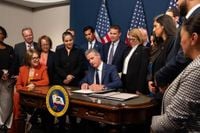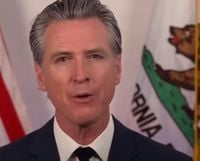California Governor Gavin Newsom has catapulted himself into the national spotlight, spearheading an aggressive campaign to redraw the state’s congressional districts in a move that has electrified Democrats and infuriated Republicans. The high-stakes gamble, which began as a provocative response to recent redistricting maneuvers in Texas, is now set to be decided by California voters in a special election on November 4, 2025.
What started as a seemingly far-fetched idea on Newsom’s own podcast has rapidly evolved into a defining moment for California politics—and perhaps for the Democratic Party nationwide. By late August, Newsom was front and center at campaign rallies, using every tool at his disposal, from social media blitzes to fiery press conferences, to tie his political fortunes to the fate of the redistricting proposal. Some have even dubbed the effort the “Gavinmander,” a nod to the governor’s hands-on approach and his willingness to take the fight directly to former President Donald Trump and Republican-led states.
According to CalMatters, Newsom declared, “It’s not the rule of law, it’s the rule of Don. And we’re standing up to that,” as he signed the proclamation setting the special election. He added, “I’m concerned about what Donald Trump is doing, and to the extent that we can provide a pathway to get support for this initiative, I’m going to continue doing everything in my power.” The urgency is palpable: if Texas Republicans succeed in adding five new GOP-leaning congressional seats, California’s plan aims to offset that shift by creating five new Democratic-leaning districts—if voters approve in November.
The legislative package, officially titled the Election Rigging Response Act, was signed into law on August 22, 2025. As reported by AP News, the act places Proposition 50 on the special election ballot and comprises several key components: Assembly Constitutional Amendment 8 (which allows a temporary congressional map if other states redraw their districts mid-decade), Senate Bill 280 (setting the election timeline and funding), and Assembly Bill 604 (establishing the temporary map if the amendment passes).
“Californians have been uniquely targeted by the Trump Administration, and thanks to the hard work of the California Legislature, they will have a choice to fight back—and bring much needed accountability to Trump’s efforts to undermine the democratic process,” Newsom said at the signing event, as quoted by CalMatters and AP News. He was joined by legislative leaders who echoed his sentiments. Speaker Robert Rivas declared, “California will not be a bystander to Trump’s power grab. We are acting to defend our state from his attacks, by taking it directly to the voters.” Senate pro Tem Mike McGuire emphasized the temporary and defensive nature of the measure, stating, “Today’s action means we’re fighting back for our democracy and our future—not with fire—but with the power of the voters and millions of folks across the Golden State.”
Senator Eloise Gómez Reyes, who stood alongside Newsom at the signing, made the stakes clear: “This is about protecting democracy, ensuring fairness in our elections, and fighting back against Trump’s power grab. Californians deserve the right to make their voices heard and to hold those undermining the democratic process accountable.”
The roots of California’s redistricting campaign trace back to Texas, where Republicans have openly acknowledged the political motives behind their mid-decade map changes. Texas state Rep. Todd Hunter, who authored the redistricting bill, bluntly admitted, “The underlying goal of this plan is straightforward: improve Republican political performance.” This candor has only fueled the sense of urgency among California Democrats. “What do we do, just sit back and do nothing? Or do we fight back?” asked California state Sen. Lena Gonzalez, as reported by AP News.
Currently, California’s electoral maps are drawn by an independent commission, a system that has enjoyed broad support among voters. If Proposition 50 passes, control of redistricting would temporarily shift to the state legislature for five years, after which it would revert to the independent body in 2030. Newsom has signaled he would be willing to abandon the plan if Texas reverses course, but so far, both sides appear entrenched.
Opponents, especially Republicans in California, have framed the move as a naked power grab orchestrated to boost Newsom’s rumored presidential ambitions for 2028. Assembly Republican Leader James Gallagher argued, “He’s clearly decided to do this to further his presidential ambitions. He wants to be seen as the person fighting Trump and to galvanize the Democratic base behind him. It’s not about some greater cause. It’s about him and his image and his ambitions.” Gallagher went further, warning that a defeat at the ballot box could be “the death knell for his political career.”
Republican lawmakers have tried to halt the process through the courts, but so far, their efforts have been unsuccessful. The California Supreme Court rejected a petition filed by state Republicans, stating, “Petitioners have failed to meet their burden of establishing a basis for relief at this time under California Constitution article IV, section 8.” Undeterred, Republican lawmakers have vowed to continue fighting, insisting that “Californians deserve fair, transparent elections, not secret backroom deals to protect politicians.”
National Democratic figures have rallied behind Newsom’s initiative. Former President Barack Obama, speaking at a fundraiser for the National Democratic Redistricting Committee, expressed his support, saying, “On this California issue, I want to see as a long-term goal that we do not have political gerrymandering in America. That would be my preference. But I want to be very clear. Given that Texas is taking direction from a partisan White House that is effectively saying: gerrymander for partisan purposes so we can maintain the House despite our unpopular policies, redistrict right in the middle of a decade between censuses—which is not how the system was designed; I have tremendous respect for how Gov. Newsom has approached this.”
Beyond the immediate political drama, the Election Rigging Response Act is just the latest salvo in California’s ongoing resistance to Trump-era policies. State officials point to a $168 billion return in federal funding from earlier legal battles with the Trump administration, according to figures cited by CalMatters. For Newsom, the current fight is as much about protecting California’s interests as it is about shaping his own political destiny.
Yet, the risks are real. Newsom’s approval ratings have lagged, except when he is perceived as standing up to Trump. If the redistricting measure fails in November, it could deal a severe blow to his standing, both in California and on the national stage. But for now, Newsom is enjoying a surge of support from Democrats hungry for a leader willing to take bold, even combative, action. As Christale Spain, chair of the Democratic Party in South Carolina, put it, “In this time of Trump 2.0, folks are just looking for a fighter.”
With less than three months until the special election, all eyes are on California—and on Newsom, who has staked his legacy and perhaps his future presidential hopes on the outcome. The state’s voters now hold the power to decide not just the future of California’s congressional maps, but also the trajectory of one of the Democratic Party’s most prominent rising stars.



